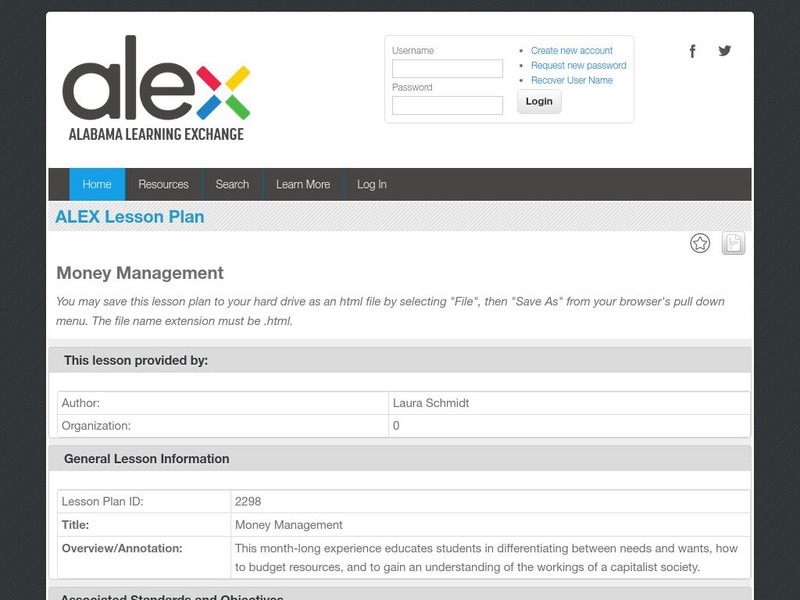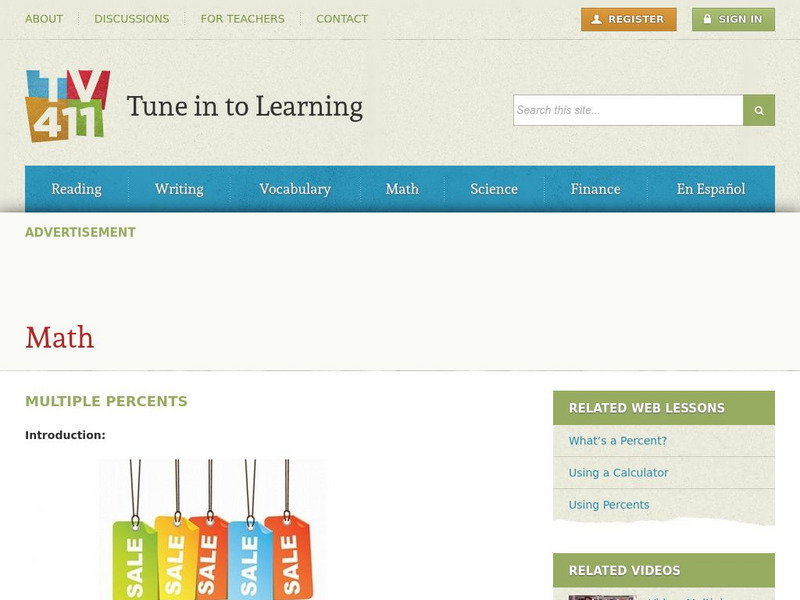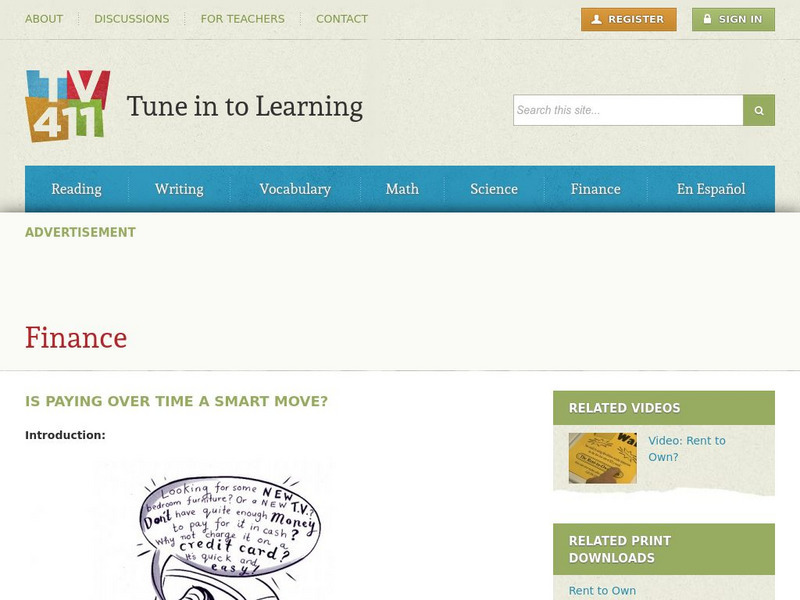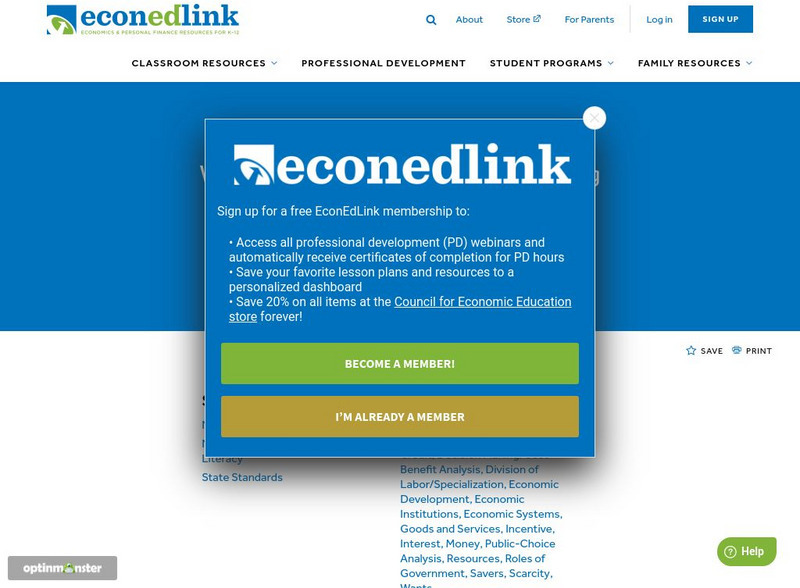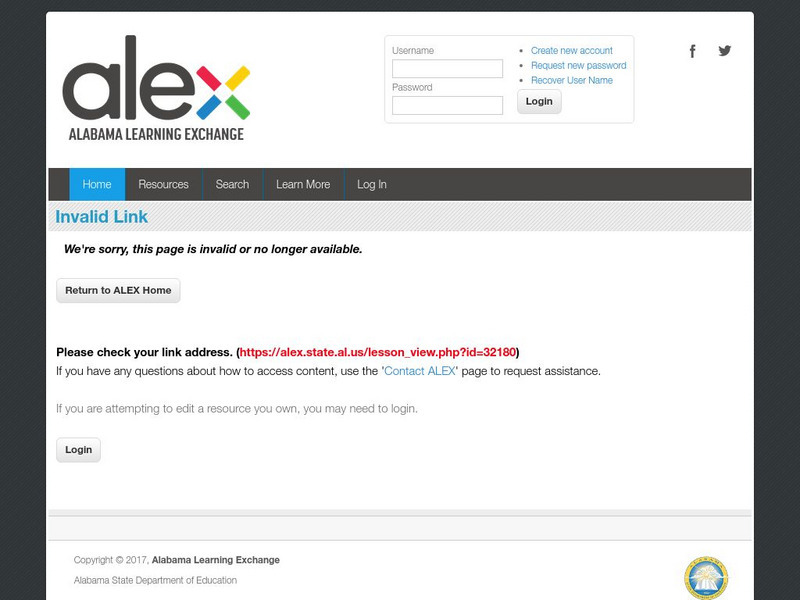Alabama Learning Exchange
Alex: Money Management
This month-long experience educates students in differentiating between needs and wants, how to budget resources, and to gain an understanding of the workings of a capitalist society.
Mangahigh
Mangahigh: Number: Money Management
This site provides students practice with the concept of money management, such as tax and inflation. Students can learn about the topic by completing an interactive tutorial. Students can then take a ten question timed test to practice...
Education Development Center
Tune in to Learning: Multiple Percents
Have you ever seen an item that you wanted on sale for 15% of its original price? Have you tried to figure out what the sale price would be? Using this interactive lesson from T.V. 411, you can learn to calculate discounts with percentages.
Education Development Center
Tune in to Learning: Is Paying Over Time a Smart Move?
At T.V. 411 you can explore the concept of paying over time with situations involving credit cards, rent to own items, and more. This interactive lesson gives the learner an opportunity to make decisions about money management.
Council for Economic Education
Econ Ed Link: Work, Earnings and Economics: Using Lyddie by Katherine Paterson
In reading and discussing Lyddie, by Katherine Paterson, students examine basic economic concepts and explore the growth of labor unions and the role of government in a market economy.
Council for Economic Education
Econ Ed Link: Clickety Clack, Let's Keep Track!
This lesson will show students the importance of keeping track of their savings.
Council for Economic Education
Econ Ed Link: Buying on Credit Video and Quiz
Video [3:28] and quiz on the concept of buying on credit.
Council for Economic Education
Econ Ed Link: Big Banks, Piggy Banks
When choosing a place to put their money, people consider how safe there money will be, how easy it is to access, and whether it will earn more money. Students explore how well different savings places achieve these objectives. This...
Council for Economic Education
Econ Ed Link: Q T Pi Fashions Learning About Credit Card Use
Credit cards are convenient, user-friendly, and at times dangerous. In this lesson, students learn the joys and dangers of using credit as they help Credit, the main character in this activity, solve her credit problems.
Council for Economic Education
Econ Ed Link: Banks & Credit Unions (Part I)
Young scholars learn about banks and credit unions, identifying similarities and differences between the two types of financial institution. They also evaluate a local bank and credit union to determine which one would be better suited...
Council for Economic Education
Econ Ed Link: Show Me the Money!
Students will investigate unforeseen costs of car loans and/or house loans. They will then evaluate the economics of decision making, the ramifications of their choices, and options available to them. Students will compute costs and...
Illustrative Mathematics
Illustrative Mathematics: Saving Money 2
The purpose of this task is for students to relate addition and subtraction problems to money and to situations and goals related to saving money. A problem is given that will contain multiple solutions, this allows students to think...
Other
Wells Fargo Bank: Hands on Banking for Kids
Mini learning modules that teach kids about money and its worth. Students also learn how to set financial goals during these interactive activities.
Other
Wells Fargo Bank: Hands on Banking for Teens
Mini learning modules that teach teens how to manage their money wisely and reach their financial goals.
Practical Money Skills
Visa: Practical Money Skills for Life: Road Trip to Savings
Arcade-style game introduces young learners to concepts of saving, spending, needs, and wants. Players have to keep their cars on the road by allocating their spending between needs (car insurance and gas) and wants.
Other
Wells Fargo Bank: Financial Information for Young Adults
Mini learning modules that teach young adults how to manage money wisely and reach their financial goals.
Other
American Institute of Certified Public Accountants: Feed the Pig
What kind of saver are you? Save the Pig has great tips and tools to help you identify your spending habits and then learn to change them in order to improve your financial health.
Alabama Learning Exchange
Alex: Becoming a Wise Consumer: Comparison Shopping
In this introductory lesson to money management for teens, students will use everyday math skills to comparison shop a variety of products. Students will learn several ways to save money, including using store discounts, coupons, and...
Alabama Learning Exchange
Alex: What Does That Car Really Cost?
In order for learners to grasp the total cost of their dream car, students must be aware of the hidden costs of a vehicle. This instructional activity will teach learners to shop for insurance and a deductible which fits their budget....
Alabama Learning Exchange
Alex: That's All I Have to Spend for a Whole Month?
As a part of the study of personal economics, students will research a career, costs of rent, insurance, food, transportation, etc. and prepare a monthly budget based on their research.
Alabama Learning Exchange
Alex: A Scents Able Solution
Students will use a variety of math operations to create a flower bouquet within a budget. This lesson plan was created by exemplary Alabama Math Teachers through the AMSTI project.
Alabama Learning Exchange
Alex: What's the Real Cost of That Car?
This is a Commerce and Information Technology lesson plan. A project requiring research, critical thinking and complex decision-making about factoring all the costs of purchasing a large ticket item - a car.
Consumer Financial Protection Bureau
Consumer Financial Protection Bureau: Tracking Income and Benefits
Using a case study about an urban family, students calculate monthly net income and explore how irregular income may make it challenging to manage monthly expenses.
Other
Balance Track: Finances for College Students: Money Management
From BalanceTrack, this section focuses on establishing financial goals, provides students with a calculator to estimate how much they should be saving each month, and provides students with a sample budget worksheet.


